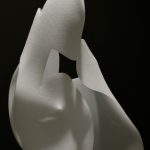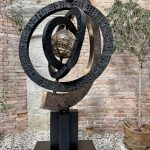Tours for blind or visually impaired travelers in Venice? You will find this city more accessible than you think. Since 2020 I have run many tours with blind tourists who have asked me to design personalized itineraries to meet their requests and interests.
A course to learn how to run tours for blind travelers in Venice
I am very grateful to some colleagues of mine who, during Covid, arranged a special course to learn how to arrange tours for blind and visually impaired visitors in Venice.
I had previously run tours for groups where one or two participants had visual challenges, but apart from being very detailed in describing what the city highlights would be like, I had little understanding how to be more professional in this sense. Special techniques and strategies exist.
Why visiting Venice with visual disabilities: pros and cons
One of my clients, traveling solo from Brazil, told me:
I was eager to come to Europe, but I didn’t know which city I could visit. Given the fact that I would not see anything, I wondered which city could give me most and I chose Venice.
Tours for blind and visually impaired travelers in Venice can take advantage from the absence of cars, the presence of people in the streets who can help with directions. Moreover, the relatively small size of the city which has always been described as on a human scale and the presence of a public transportation system are all pros Venice offers.
On the other hand, one needs to consider there are bridges and steps, there are over 160 waterways and no parapets to prevent you from falling into the canal. Although… in my experience as a licensed tourist guide in Venice, the ones falling in the water usually are tourists who drink too much and are not paying too much attention to steps turned slippery with algae when they want to take an original photo.
Some unusual tours and experiences in Venice for blind travelers
I have run tours for blind and visually impaired travelers as well as some experiences, possibly involving all other senses. You can find two proposals I have offered in the blog of the Best Venice Guides.
Venetian boats and rowing class in Venice
One tour regards the history of boats in Venice and will bring you into the history of building boats in Venice, learning about the different shapes, the technical details, how the gondola changed throughout the centuries, the different oarlocks, the special oars.
The tour includes also a rowing class on a traditional wooden boat: https://bestveniceguides.it/en/2022/03/30/tours-in-venice-for-the-blind-and-visually-impaired-visitors-the-boat-tour/?
I remember the lady who thought we would just take her on a gondola ride and how enthusiastic she became when she learned she would row! I love rowing and for me it’s like yoga, something soothing, relaxing and not tiring at all. So while someone rows at the stern, we will row together at the bow of the boat, standing, face forward as all Venetians do —and yes, gondoliers, too.
I can tell someone has just done their washing!
I can feel the wind and the current have changed
It’s so silent and gently slow, you need to touch the water to understand we are moving
The history of Venice Carnival: masks and exotic drinks
The other experience which has also acquired passionate feedback is the one regarding the history of Carnival: https://bestveniceguides.it/en/2022/05/30/tours-in-venice-for-the-blind-and-visually-impaired-visitors-the-carnival-tour-2/?
Masks in papier-mâché are still made in Venice by talented artisans and touching the molds, the different materials and understanding the meaning of each mask of the Italian Comedy called Commedia dell’arte is something really fascinating.
Moreover, in Venice there’s a wonderful laboratory where chocolate tasting can be arranged —well, yes, it’s a hard job but don’t you know which essential role exotic drinks such as coffee, chocolate and tea played in the 18th century when Mardi Gras reached its hey day? So why not understanding the Venetian society from their favorite drink?
The Silk Road: exploring textiles in the weaving mill Luigi Bevilacqua
There is a third option I love offering and it regards another major chapter in Venetian history: the silk road. Weaving velvet is still a lively presence in contemporary Venice. The Luigi Bevilacqua weaving mill is located in the beautiful district of Santa Croce and when you enter their space, the sound of 300 year old looms will entrance you with its ancient rhythms. I wrote more about this here: https://www.seevenice.it/silk-velvet-weaving-and-weavers-venice/
Velvet “soprarizzo”: a unique tradition of Venice
Silk velvet made at Luigi Bevilacqua is unique because of its three layers, i.e. the warp, the curled silk thread and the cut pile. The weavers know they are the only ones in the world who can still make this so-called “soprarizzo” technique, which can only be made by hand. The weaving mill has been active since 1875 and one can touch the punched cards, feel the different patterns (over 3500), the different tools, the warper machines, the spools.
Touching and understanding different fabrics is fascinating. Fabrics can be as soft as baby skin or it can be more rigid if real gold mixes with cotton or silk yarn. What an incredible way to delve into the history of when Venice excelled in the textile sector!
Also measuring the time and expertise it requires to set up a loom before weaving is part of the experience. Not to mention to understand how you fix the threads when they break, and what the different types of knots there are!
Hand-made broccato lampas in Venice
Recently one of the weavers has engaged herself in trying a different technique from velvet, broccato lampas.
Broccato lampas is a kind of precious fabric in silk with usually a splendid floral design. The level of concentration needed to make broccato lampas by hand is incredibly high. The weaver works on the back of the textile directions, twisting together almost twenty different threads, each in their own shuttle.
She uses a mirror to check the pattern is correctly made. No wonder only 5cm a day can be produced.
Apart from these experiences and tours for blind and visually impaired visitors, all tours above can be arranged for everyone. And it is also true that any tour in Venice can work for blind and visually impaired visitors. Venice is accessible and unique for all curious travelers with an open mind.
by Luisella Romeo
registered tourist guide in Venice, Italy
www.seevenice.it



















Free of cars – and if you choose your off-season period carefully, nearly free of the huge number of day-trippers – Venice really is a wonderful option for the sight impaired. And what a combination of experiences you offer, Luisella! Rowing, chocolate, mask making, silk weavers! But there is also the enormous joy – once your tour is over – for the blind person to sit with an ombré and plate of cichetti in a Venetian wine bar, to enjoy gelato at an outside table on the Zattare as you listen to the swooping seabirds, to test the intriguing perfume samples at The Merchant of Venice perfumerie or to attend a concert – Vivaldi! in a great church.
Sometimes, I find the best way to soak up the atmosphere of Venice – especially at night, when it can be so silent, standing on a bridge, is with my eyes closed.
So true! And what about exploring hidden gardens with their scents? Grazie, my dear Jill! Great suggestions, too!!!